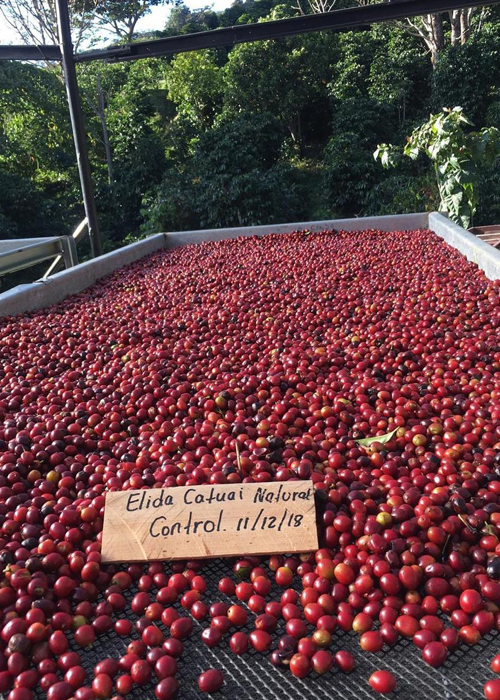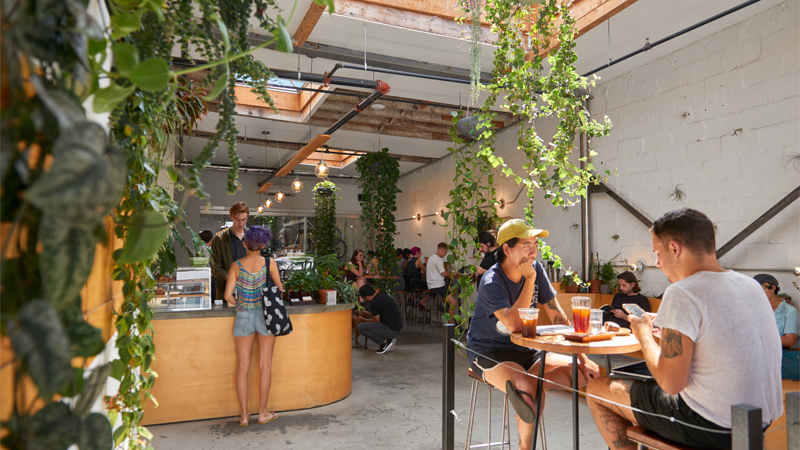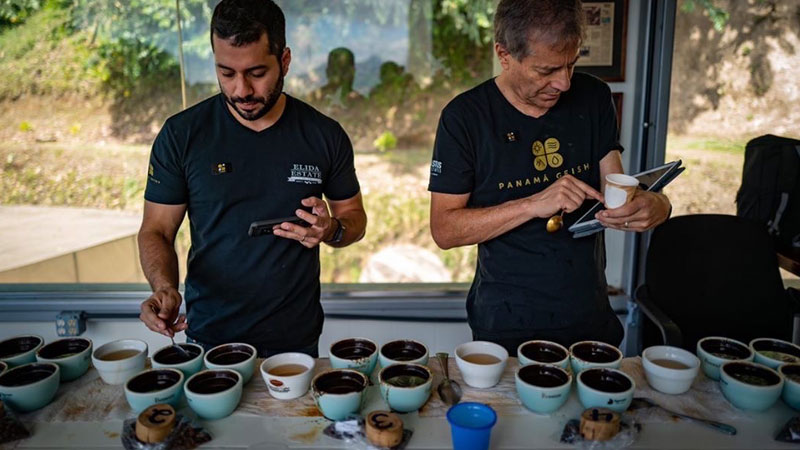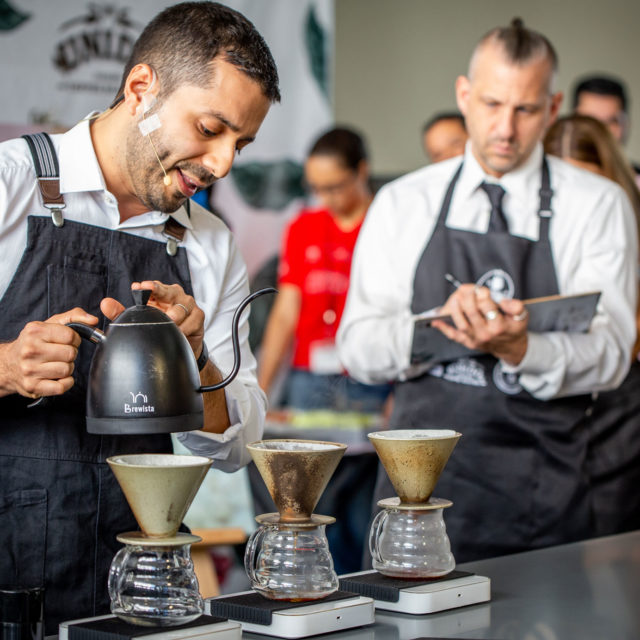In May 2019, Lamastus Family Estates crushed the record for highest score in the prestigious Best of Panama (BoP) coffee competition created by the Specialty Coffee Association of Panama. Of a total of 174 coffees submitted to the competition, 78 of which were selected to be evaluated by a panel of international judges, the family’s Elida Geisha Green Tip Natural scored 95.25 out of 100 points.
At precisely 8 p.m. on July 16, 2019, Wilford Lamastus Jr., a fourth-generation coffee producer, received the news that his family estate’s coffee had just sold at the BoP annual auction at $1,029 for a single pound. It is by far the highest-valued coffee ever sold.
High value is placed upon Geisha coffee, the Lamastus Family Estates’ speciality, year after year in the BoP cupping competition. But the coffee’s price and significance go beyond this annual “Grammys of coffee.” This record-breaking price has transitioned coffee growing in Panama from a quotidian commodity to international stardom — and its effect is felt everywhere from Hitachinaka City, Japan to Bushwick, Brooklyn, NYC.
Lamastus Family Estates specializes in Geisha coffee, a variety originating in Ethiopia. Geisha coffee (also spelled Gesha) has become popularized worldwide by Panama as a luxury-statement coffee after the varietal was discovered in 2004 in Chiriquí, Panama by way of Costa Rica by Daniel Peterson from Hacienda La Esmeralda.
Geisha is also produced in Guatemala, Honduras, El Salvador, Bolivia, Colombia, and Costa Rica, in addition to Ethiopia and Panama. Year after year, the Panama Geisha coffee varietal keeps skyrocketing in price sold per pound, sparking international headlines and caffeinated buzz reverberating around the globe. Before surpassing the four-figure mark in 2019, it previously sold for $803 per pound in 2018, and the year before at $661 per pound. The first Geisha ever auctioned (in 2004) was a Washed Geisha from Hacienda La Esmeralda and was sold for $21 per pound. The most expensive auctioned coffee at that moment was sold at $4.80 per pound.
So what makes a single pound of coffee worth over a grand? For even the utmost discerning coffee drinkers, Panama Geisha is worth its astronomically high price tag due to its rarity, production costs, and superior flavor. And for those who don’t consider themselves coffee snobs per se, Panama Geishas have been known to change minds in a single sip.
Panama Geisha Terroir
This particular, record-breaking coffee (and other Panamanian Geishas of high auction value) is a result of Panama’s climate, soils, and other aspects such as sea level and geographic positioning that affect the taste of Geisha coffee. You may already be familiar with this concept: It’s called terroir, and yes, coffee has it, too.
At least, that’s what many coffee aficionados believe — and what keeps Panamanian Geisha continually climbing in auctions and competitions around the world. The unique microclimate in Panama is caused by a combination of winds from the north (Caribbean) and the south (Pacific) in the mountain range and its potassium and calcium-rich volcanic soils surrounded by virgin forest. This creates a balanced natural shade and acts as a windbreaker, protecting the delicate Geisha branches’ coffee cherries. The geographic position of Panama and the narrow distance between ocean and ocean, called the isthmus, makes it unlike any other coffee growing region in the world.

The Geisha varietal grown in Boquete and Chiriquí demonstrates the varietal’s hallmark floral and delicate notes of jasmine, bergamot, peach, lemongrass, and red fruits. Geisha can be processed, washed, natural, or any special process.
“These qualities [of Panama Geishas] are hard to replicate in other Geisha-producing countries because they do not have the same special altitudes and soils as in Panama,” says Lamastus Jr.
Breaking Records Worldwide
Today, more than 15 countries produce Geisha with seedlings originating in Panama. But no country is on the same level as Panama for quality as set by competitions and evaluations. It is Elida Estates owned by the Lamastus family that has brought these record-breaking Geishas to global attention at these competitions.
LFE began in 1918 in Boquete, one of the most famous coffee-growing regions in the world, by Kentucky-born Robert Lamastus.
Elida Estate’s Geishas were also awarded with the highest-ever score in CoffeeReview.com, scoring the first 98 points the website has ever given to any coffee.
There are other factors too, such as the expensive market cost of land in Panama compared to other coffee growing countries, lower bean yield of Geishas per branch versus other Arabica coffee varieties, and basic supply and demand. Prices for these specialty Geishas can be simply driven up due to rarity, as it happens with some Romanée Conti Burgundy wines that go for upwards of $20,000.
“If someone wants the best, they are typically willing to pay to enjoy it, especially since they can taste the difference,” says Mike Perry, founder of Klatch Coffee in Cucamonga, Calif., Best of Panama judge, and buyer of this 2019 Elida Geisha.
Because of all these factors, buyers were willing to bid all the way to $1,029 for a single pound of coffee.
“It is because buyers understand the work done [to the coffee] and they predict continuity in quality; those things let them feel better on doing those crazy expensive bids,” says Lamastus Jr.
Who Is Buying These Ultra-Expensive Coffees?
Buyers from all over the world bid on this Elida Estate Geisha coffee, including Japan’s Saza Coffee, California’s Klatch Coffee, Connecticut’s Willoughby’s Coffee & Tea, and Colorado’s Dragonfly Coffee Roasters.
“The coffee was so sweet, clean, and fruity. It reminded me of candied fruit, like Jolly Rancher and Lifesavers. I fell in love with the flavors in the cup, actually giving this coffee 97+ points, my highest score ever, so I knew I had to buy this at the Best of Panama auction,” says Perry.
Barry Levine, owner and CEO of Willoughby’s Coffee & Tea in Connecticut and BoP judge, also says he awarded this Elida Estate geisha the highest score of his career.
“With only 100 pounds available worldwide, I wanted our company to have some, even though the price was extraordinary,” says Levine.
On the consumer side, it seems everyone wants a sip of Geisha coffee — and it’s people from all different economic backgrounds, lifestyles, and countries. At his coffee shop in California, Perry sees everyone from “foodies,” students, and younger people who love specialty coffee, to those who can afford to pay the higher prices for quality. Levine receives international orders for these Geishas from Asia and Saudi Arabia.
Lance Schnorenberg from Sey Coffee in New York (who has purchased and offered these pricey Geishas at his Bushwick Cafe in years past) sees “experience-driven” consumers: people who go out to quality-focused restaurants or buy a nicer beer or glass of wine.
“We’re also seeing a shift in the actual service industry. Trying to make food, beer, wine, and coffee more accessible in both pretense as well as price tags,” says Schnorenberg.

What A $1,000 Coffee Means for the Industry
Record prices prove people will pay for quality. The value of the auction coffees — Geisha or otherwise — has been pulled up by the Geisha growth and, parallel in other countries’ auctions, the price of their coffee rose as well. In 2019, the cheapest coffee in the BoP auction sold was around $30 a pound and, at the same time, market value of specialty coffee got stabilized.
Most Geisha coffees are more expensive than traditional varietals, generally within the $30- to $200-per- pound range for the majority of top growers. But the worldwide market for commodity coffee is actually suffering from prices that are too low.
“The base commodity price at the moment for Arabica coffee is a ridiculously low $1 a pound, so this coffee [Elida Estate Panama Geisha], at the other end of the range, is truly an anomaly,” says Levine.
Lamastus Jr. experimented with the Anaerobic Slow Dry (ASD) method, learned from the wine industry, which is partly why his family’s coffee specifically achieved $1,029 per pound.
After Geisha’s success in Panama, several foreigners invested in coffee plantations in the country. “Coffee tourism” picked up, with organizations like La Cosecha bringing industry professionals and consumers to Geisha coffee growing regions like Boquete and Chiriquí. It has inspired producers in other countries like Colombia and El Salvador to plant it due to its media and market recognition, although issues in seed traceability, an understanding of the global market, and the skills it takes to grow delicate Geishas have arisen for producers and farmers outside Panama.
How This Will Affect Your Daily Cup
On a day-to-day basis, consumers will still drink commercial-grade coffee.
But the public is slowly moving toward specialty coffee. For the consumer, record prices have caused many to realize the best coffees are like the best wines or whiskeys, worthy of being enjoyed for more than their chemical jolt.
Klatch Coffee offered individual tasting experiences in San Francisco last year for $75 per cup of their natural-process Geisha from Elida Estate. Saza Coffee in Tokyo sold around 50 cups a month of Elida Geisha at $140 per cup.
“But in the broader coffee market, I do not think someone who gets his or her morning coffee at the local convenience store or donut shop is going to start buying record-breaking Panama Geishas at $100 per cup,” says Schnorenberg. “But they will stop into a local coffeehouse to try a specialty coffee to see if it is good. And he will taste the difference and become a regular at his or her local coffeehouse.”
He cites his truck driver father-in-law as an example, a historic consumer of bad gas station coffee.
“Now having experienced specialty coffee from us [at Sey Coffee], he always asks if we can bring him some over, because now that he has tasted the difference and prefers to only drink good coffee,” Schnorenberg says.
Craft Coffee Is Worth It – ‘Taste the Difference’
“For those who prefer a craft beer over Budweiser, top-shelf liquor over house liquor, a nice glass of wine over the house selection, Panama Geisha is worth it because you can taste the difference,” says Perry.
Most people view coffee more as a utility, not a culinary experience. Wine is more often consumed to enhance a dining experience or as a sophisticated social beverage. To get consumers to pay more attention to coffee as a luxury or a culinary experience like wine, says Dustin Wilson, Master Sommelier (formerly Eleven Madison Park) and co-founder of Verve Wine, we have to first change people’s habits around why they consume it.

Fine-dining restaurants and chefs are integral in shifting consumer perceptions.
“If a high-end restaurant got some super-sick beans, treated them correctly, and could articulate why it’s a rarified experience and help the guests learn how to appreciate it, that could really elevate things [for coffee],” says Wilson.
Chef and owner Mario Castrellon of Maito, a Latin America’s 50 Best restaurant in Panama, serves top Panama Geishas tableside at his fine-dining restaurant and suggests restaurants hire a barista or specialist who can prepare a proper coffee and then talk about it to diners.
“People pay over $100 for a Grüner Veltliner all the time nowadays and that was unheard of 10-plus years ago. If we can do that, we can probably get people to buy a $25 cup of coffee someday at a nice restaurant,” says Wilson.
